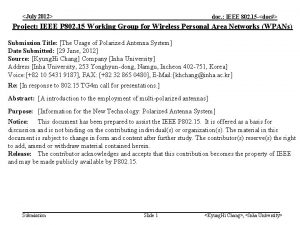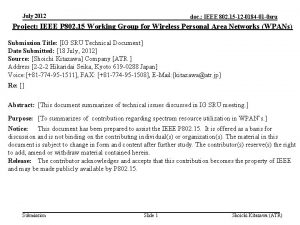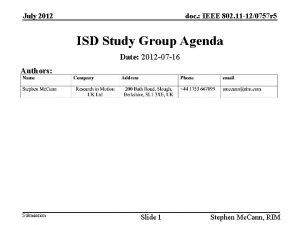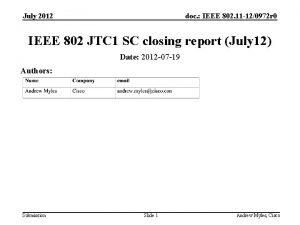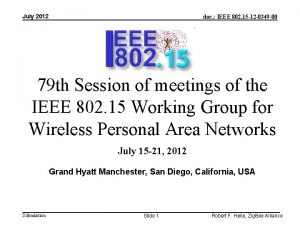July 2012 doc IEEE 802 11 12775 r










- Slides: 10

July 2012 doc. : IEEE 802. 11 -12/775 r 1 Efficient Probe Filtering Authors: Submission Date: 2012 -07 -05 Slide 1 Steve Grau, Juniper Networks

July 2012 doc. : IEEE 802. 11 -12/775 r 1 Abstract Several submissions to TGai have proposed probe filtering schemes, such as inclusion/exclusion lists and regular expressions, in order to reduce the number of unnecessary probe responses generated by probe requests. This proposal suggests an alternate filtering mechanism that is more efficient for an AP STA to evaluate than other proposed schemes. This proposal is submitted as an alternative approach to consider should the task group choose to include probe filtering in the TGai amendment. Submission Slide 2 Steve Grau, Juniper Networks

July 2012 doc. : IEEE 802. 11 -12/775 r 1 Concept The concept presented in this submission is to use bit masking to enable complex inclusion filters to be implemented in such a way that the filter is trivial for an AP to evaluate when processing a probe request. The filtering mechanism implements a Boolean expression of the form: Respond = (SSID_1 || SSID_2) && (HESSID_A || HESSID_B) || … The filter expression is computed by the probing STA and transmitted as a Filter Element in a probe request. Each receiving APs uses the Filter Element and a pre-computed mask, based on its configuration, to avoid responding to a probing STA that is uninterested. The filter is not perfect, but thins the number of responses by eliminating a potentially large percentage of undesired probe responses. Submission Slide 3 Steve Grau, Juniper Networks

July 2012 doc. : IEEE 802. 11 -12/775 r 1 Filter Element-based Active Scanning AP 1 STA AP 2 Probe Request (Filter Element, …) Filter Element & Mask 1 != Mask 1 (Do not respond) • • • Probe Response Filter Element & Mask 2 == Mask 2 && Pre-FILS Conditions Match (Respond) Filter Element – bit mask computed by STA from fixed list of filtering parameters (e. g. SSID, HESSID, etc) Maskn – bit mask that is pre-computed by APn. The mask is pre-computed using the same algorithm used to compute the Filter Element The filter check on AP is a simple mask and compare operation, making it lightweight computationally The filter test will not eliminate all unnecessary probe responses, but it could eliminate a large percentage of them in many cases Doing filter test prior to pre-existing tests provides an efficient pre-filtering mechanism Absence of Filter Element in probe request results in current behavior Submission Slide 4 Steve Grau, Juniper Networks

July 2012 doc. : IEEE 802. 11 -12/775 r 1 Filter Element F 1 F 2 F 3 F 4 F 5 Fn • Filter Element is a bitmask consisting of a number of sub-filters (F 1 Fn) • Each sub-filter consists of a portion of the bitmask related to a particular filtering parameter, such as SSID or HESSID. The list of filtering parameters is TBD. • Values of interest are hashed to select a single bit in the mask (note: multiple values of a single parameter will hash to each bit but a particular value will map to only one bit) Submission Slide 5 Steve Grau, Juniper Networks

July 2012 doc. : IEEE 802. 11 -12/775 r 1 Filter Element Construction • For each value of interest, compute its single-bit bitmask: Fx = 0 x 1 << ((hash(param_x) % N_BITS_Fx) + Fx_SHIFT) • Bitwise OR all of the bitmasks together to construct the Filter Element • Lists of parameter values are handled by computing the above mask for each list element and including it in the above bitwise OR • ANY (wildcard) is specified by setting all bits in a particular sub-filter • Concatenation of all sub-filters into the filter implicitly results in a Boolean AND of all of the sub-filters Submission Slide 6 Steve Grau, Juniper Networks

July 2012 doc. : IEEE 802. 11 -12/775 r 1 AP Mask Construction • For each sub-filter element, compute its single-bit bitmask based on the AP’s value for the associated parameter: Fx = 0 x 1 << ((hash(param_x) % N_BITS_Fx) + Fx_SHIFT) • Bitwise OR all of these sub-filter bitmasks together to construct the AP’s Mask • Note: This is pre-computed based on AP configuration rather than being computed for each probe request Submission Slide 7 Steve Grau, Juniper Networks

July 2012 doc. : IEEE 802. 11 -12/775 r 1 Filter Evaluation • AP evaluates filter while processing each probe request: if (Filter Element present) { if ((Filter Element & AP Mask) != AP Mask) { // do not respond } } / / continue with normal probe request handling Submission Slide 8 Steve Grau, Juniper Networks

July 2012 doc. : IEEE 802. 11 -12/775 r 1 Conceptual Example • • • F 1 F 2 F 3 F 4 TG defines filter with 4 8 -bit sub-filters • F 1 assigned to SSID, F 2 -F 4 assigned to other parameters, #2 through #4 Enterprise AP beaconing 3 SSIDs, BSS 1 and BSS 3 have the same parameter values for filter parameters #3 and #4 STA 1 probing for BSS 2 SSID STA 2 probing for BSS 3 SSID STA 3 probing for any SSID with a combination of parameter 2 through 4 desired values. Only parameter #2 values differ between BSS 1 and BSS 3 Probe Filter AP Mask BSS 1 BSS 2 BSS 3 0 x 01020408 0 x 02102040 0 x 04800408 STA 1 0 x 02 ffffff Omit Respond Omit STA 2 0 xff 80 ffff Omit Respond STA 3 0 xff 020408 Respond Omit Submission Slide 9 Steve Grau, Juniper Networks

May 2012 doc. : IEEE 802. 11 -12/775 r 1 Motion • Move to add the following text to Clause 6. 1. 6 Omission of Probe Response of the TGai Specification Framework Document (11 -12/0151 r 09): “A FILS capable STA may include a probe response filtering bitmask element in a probe request as outlined in 11 -12 -0775 r 0. A FILS capable AP STA receiving a probe request with a probe response filtering bitmask element should apply the filter, as outlined in 11 -12 -0775 r 0, to omit issuing a probe response if the filter indicates a response is not required. ” Moved: Seconded: Vote: Y/N/A Submission Slide 10 Steve Grau, Juniper Networks











